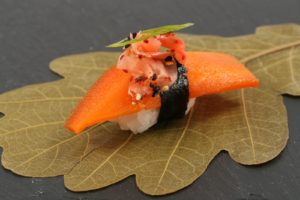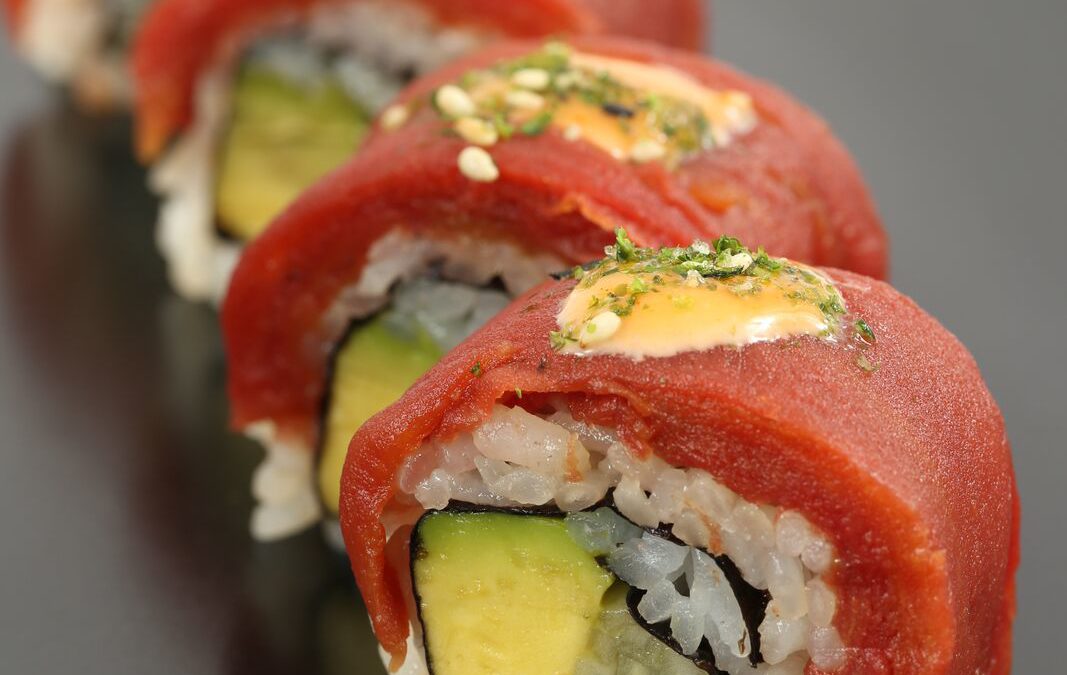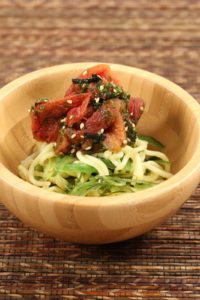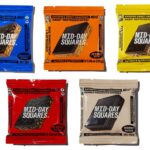My friend Mike Schall asked me if I had heard of Ahimi®, a plant-based substitute for Ahi tuna. He knows how much I love sushi-grade Ahi and I know that Mike has a passion for all things plant-based.
Coincidentally, my daughter Fanny’s recent TV appearance on Cooking Channel on The Best Thing I Ever Ate, had her presenting her passion for a panko-crusted Ahi in wasabi butter sauce from Sansei in Hawaii. The video is hilarious and makes me crave their fantastic cuisine. We even served this dish at our other daughter Sarah’s wedding this summer.
Ahi is my BFF.
But Ahimi® was new to me, and the idea of a plant-based tuna substitution made me fish around to understand the marketing strategy. Mike introduced me to the folks at Ocean Hugger Foods.
I guess I was looking for an Aha/Ahi moment.
How Do You Sell a Plant-based Ahi Product?
 I spoke with Ashley Bouldin, Director of Marketing at Ocean Hugger Foods based in New York. Ashley is an experienced seafood marketer and deeply committed to the brand’s strong values-based work. She explained their mission:
I spoke with Ashley Bouldin, Director of Marketing at Ocean Hugger Foods based in New York. Ashley is an experienced seafood marketer and deeply committed to the brand’s strong values-based work. She explained their mission:
Create delicious, sustainable plant-based alternatives to popular seafood proteins that delight even the most discerning palates.
The idea for Ocean Hugger Foods® first started to take shape at the Tsukiji fish market in Tokyo, where Chef James Corwell saw two football-field sized warehouses full of tuna sold in one morning. Chef Corwell — one of only 60 Certified Master Chefs in the U.S. — saw the incredible volume of tuna that are sold every single day, and asked: “How can the oceans ever keep up?”
The answer is “they can’t.”
According to a study published in the journal Nature, 90% of all large predatory fish (like tuna) are already gone, and the rate of fishing isn’t slowing down.
So, Corwell started working on something that could make a difference in the world’s oceans. Ahimi,® a plant-based alternative to raw tuna, is their first product and can be used in dishes including sashimi, nigiri, poke, tartare and ceviche. According to Corwell,
“With a taste that even fish eaters will love, our products help chefs offer their diners fantastic and turnkey plant-based options. In addition to Ahimi®, the company will soon be releasing additional products to replace eel, salmon and more.”
Ashley and I spoke about the opportunities and challenges faced by bringing an alternative product to the market. I’m looking forward to learning more from David Benzaquen, their CEO and an experienced natural foods expert.
What is in Ahimi®? Roma tomatoes, non-GMO soy sauce, sugar, water, and sesame oil.
One of the fastest growing categories for new product introductions is alternative plant-based products.
Impossible Burger, Kite Hill, Plantiful by Lifeway, No Evil, Vega Cashew milk yogurt, Quorn’s fishless fish sticks, MALK (cashew milk), Reveri (Plant-based frozen dessert), Engine 2 Diet products, Mami’s Gelato, Pan’s mushroom jerky are just some of the many plant-based foods being introduced into retail and food service in the last few years.
Ahimi®, like these other products, has to be explained, requires strategic discipline and tactical testing.
During our call, I must have asked Ashley a thousand questions. I’m curious about their approach and how they see the market.
The following lists outline some observations and thought-starters for anyone going down this path of selling an alternative to the well-known product. I use Ahimi® as an example of these questions, but they apply to companies thinking about plant-based alternatives to replace beef, bacon or burritos.
Questions on My Mind
- Positioning: Do you want to position Ahimi® as an alternative to tuna sushi, or would you be better served not being linked to an existing product form with set expectations? For example, what happens if they created Ahimi® steak or filet versus a small piece used on a sushi roll? It could be sliced for Ahi-type sushi but also used in the traditional center of plate entrees too? What Impossible Burger did by giving their plant-based alternative beef to chefs, was to let them imagine how to use it at their restaurants. It produced a lot of great awareness and a great range of usage occasions.
- Learning from others: What lessons can you learn from non-alcoholic beer or wine, plant-based burgers, plant-based milk & yogurts or tofu hot dogs? I’m a big fan of studying the challenges others faced and the success stories they had from their experiences. It is fun to carve a path, but sometimes it helps to follow someone who has already cleared a little ground.
- Focused Channel: I believe that you need to focus on one channel and concentrate your efforts in that space. Selling through traditional or specialty retailers is entirely different from selling through foodservice. Doing both is extremely difficult for mature companies. How can you be remarkably successful with a small, limited number of customers in a contained test? If you can’t find ten customers who love your product so much that they want to tell others, then something may be wrong. Having thousands of indifferent customers won’t help you grow, especially if word of mouth is core to your strategy.
- Addressable Market: What market are you serving? How large is that market? If 20% of the U.S. population eats sushi is that the target? Or, should you be focusing on the growing population who are eating a plant-based diet and see an opportunity to enjoy this product in other eating occasions. Where else could alternatives to fish proteins be sold that might represent a more valuable opportunity?
- Forget Scaling: Instead of selling through distribution into retail or food service, would you be better served in the first three-years to create your own, non-scalable feedback loop by selling to partners directly. Knowledge, observation, and insight tend to drive successful marketing efforts and go-to-market strategy. How close can you get to the end user to understand the opportunity? Scaling is overrated. The guys who started Airbnb didn’t worry about scale when they went and photographed rentals themselves to prove that their business model worked. Against conventional wisdom, when my wife and I grew our wholesale bakery business, we didn’t hire distributors at first. Instead, we did it ourselves to be close to the market and customers.
- Cultural Trends and Patterns: The growth of Poke and salad restaurants is intriguing along with the way that plant-based products are steadily moving into the mainstream. Whole Foods, Sprouts, and other more natural food chains are increasing their emphasis on plant-based goods. What can you deduce from these patterns that might lead you to think about how you approach the market? How could alternative seafood proteins fit and be part of where animal proteins get added to salad?
- Jobs to Be Done: Who are you selling? What job are they trying to get done? How important is convenience versus the value-based positioning of your products? Do you have clear profiles of the type of customer you need to convince to use the product (whether B2B or B2C) What motivates them to try something new – how will you make it easy for them? How will you over deliver value?
If you are a chef and want to see how the Ahimi® is sold and can be used, watch this video from Chef Corwell.
I’m hooked. I’ll be watching this fascinating alternative fish story come to life.
Fishing for some marketing advice? You can set up a time to chat with me about your marketing, communications and messaging challenges using my calendar. Email me jeffslater@themarketingsage.com Call me. 919 720 0995. The conversation is free, and we can explore if working together makes sense. Try my new chat feature on my site if you have a quick question
Photos courtesy of Ocean Hugger Foods.
Note: I do not take pay for posts. I write about products, marketing, and branding that catches my attention.





